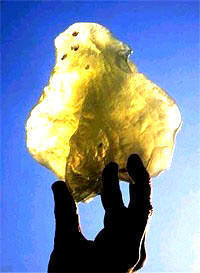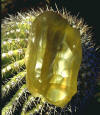|

Libyan Desert Glass
by
Gerhard MŘehle
February 1998
 The Libyan Desert of Egypt is one of Earth's most remote and inhospitable
regions. Uninhabited, windblown and foreboding, the Sand Sea, near the Gilf
Kebir Plateau, was nonetheless the site of a remarkable discovery in 1932.
The Egyptian Desert Surveys under the able direction of Englishman Patrick
A. Clayton (1896-1962) recovered specimens (about 50 kg) of an unusual,
often beautiful, translucent to transparent, yellowish-green gem-like, high
silica natural glass. The Libyan Desert of Egypt is one of Earth's most remote and inhospitable
regions. Uninhabited, windblown and foreboding, the Sand Sea, near the Gilf
Kebir Plateau, was nonetheless the site of a remarkable discovery in 1932.
The Egyptian Desert Surveys under the able direction of Englishman Patrick
A. Clayton (1896-1962) recovered specimens (about 50 kg) of an unusual,
often beautiful, translucent to transparent, yellowish-green gem-like, high
silica natural glass.
 After the 1932 discovery of Libyan Desert Glass, only two other expeditions
(both of the 1930s) were undertaken to the location until 1971. This latter
exploration involved three scientists stopping over for only two hours and
collecting some 24 samples of the glass. During this brief visit, the
expedition accidentally found the site of a forced landing of an Egyptian
aircraft with the remains of nine men. The failure of Egyptian authorities
to find the downed airplane for over three years is solemn validation of the
remoteness of this arid region. After the 1932 discovery of Libyan Desert Glass, only two other expeditions
(both of the 1930s) were undertaken to the location until 1971. This latter
exploration involved three scientists stopping over for only two hours and
collecting some 24 samples of the glass. During this brief visit, the
expedition accidentally found the site of a forced landing of an Egyptian
aircraft with the remains of nine men. The failure of Egyptian authorities
to find the downed airplane for over three years is solemn validation of the
remoteness of this arid region.
In light of the foregoing, it is perhaps remarkable that a greater abundance
of Libyan Desert Glass has been made available recently for collections and
study than at any time since its discovery 65 years ago.
 Libyan Desert Glass is classified by most meteoriticists with the group of
curious natural glasses known as tektites. In 1900,
Professor Franz E. Suess
of Vienna coined the term tektite from the Greek tektos meaning
"melted or
molten." Tektites are compositionally restricted, high silica, natural
glasses distinguishably different from other, volcanically derived, natural
glasses. Tektites range in size from microscopic (less than 1mm) to
macroscopic weighing many kilograms. They exhibit a marvelous range of
colors from water clear, gem quality, deep forest greens of moldavites to
the soothing pale to dark yellow and yellow-greens of Libyan Desert Glass as
well as the stygian, impenetrable black of Australites. Libyan Desert Glass is classified by most meteoriticists with the group of
curious natural glasses known as tektites. In 1900,
Professor Franz E. Suess
of Vienna coined the term tektite from the Greek tektos meaning
"melted or
molten." Tektites are compositionally restricted, high silica, natural
glasses distinguishably different from other, volcanically derived, natural
glasses. Tektites range in size from microscopic (less than 1mm) to
macroscopic weighing many kilograms. They exhibit a marvelous range of
colors from water clear, gem quality, deep forest greens of moldavites to
the soothing pale to dark yellow and yellow-greens of Libyan Desert Glass as
well as the stygian, impenetrable black of Australites.
Isotopic data shows there are at least six recognized geographical
distributions (strewnfields) of tektites on Earth.
In addition, a few other concentrations of natural glasses are being studied
for possible inclusion as bona fide tektites. The study of microtektites, in
particular, has dramatically expanded the size of some of the known strewnfields.
Tektites are often confused with obsidian. While both are natural glasses,
the volcanic origin of obsidians has been undeniably established. The origin
of tektites, on the other hand, is not well understood and the conflict of
theories remains puzzling and unresolved. In many ways, the large chunks of
natural glasses such as Libyan Desert Glass and Muong Nong tektites are even
more puzzling than the more traditionally recognized aerodynamic tektite
forms.
Mankind has wondered about, and cherished, these enigmatic, exotic objects
for hundreds of years, perhaps much longer. In the Cro-Magnon Venus of Willendorf site
(Austria), dated at 29,000 BC, small moldavite flake blades
were found (now lost!). The earliest written records come from mid-10th
century China referring to the black, shiny objects found after rainstorms
as lei-gong-mo, "inkstones of the thunder-god". Australian Aborigines called
Australites ooga, "staring eyes".
The origin and source of tektites
remains a mystery. In a historical
context, the earliest theories surmised an artificial provenance. (i.e.
manmade glasses). Charles Darwin made the first scientific study of tektites
(Australites) during his famous five year voyage on HMS Beagle. He deduced a
volcanic origin. Fortunately his theory of evolution was more astute than
his belief that tektites were volcanic bombs! His opinion on tektite
origins, however, held sway until the beginning of the 20th century. Since
then, a multitude of other theories, including several extraterrestrial
origin possibilities, have been advanced. Current opinions favor a
terrestrial impact related paradigm. However, each proposed theory, while
demonstrating evidence in its own favor, continues to frustratingly yield
contradictory results favoring alternative origins.
In 1973, in Meteorites and Their Origin, the author notes, "At present there
is a conflict of evidence concerning the origin of tektites, a conflict that
is only complicated by the introduction of refined instrumental methods of
researchThey appear sui generis, one of the unexplained natural science
phenomena." This statement is still valid almost a quarter of a century
later.
In relation to all other tektite groups, Libyan Desert Glass exhibits a
noteworthy number of unique attributes.
-
Lowest refractive index: 1.4616
-
Lowest specific gravity: 2.21
-
Highest silica content: 98%
-
Highest lechatelierite particles: fused quartz
-
Highest water content: 0.064%
-
Highest viscosity: almost 6X greater than Australites at the same
temperature
-
Other unique attributes: Color,
-
Bubble types: 100% of included bubbles are lenticular or irregular.
Libyan Desert Glass is classified as a Muong Nong type of tektite, i.e.
broken chunks from a layered mass. The three other classifications of
tektites include,
1) the microtektites
2) splash form types (dumb-bells,
drops, flattened spheres)
3) the most prized, flanged buttons
Hand
specimens of Libyan Desert Glass, when help up to the light, readily reveal
the internal layering and stratification of included bubbles and smoky,
dusky-brown curtains of fine particulate matter. There is no evidence
whatsoever, of atmospheric aerodynamic shaping and it is therefore presumed
that Libyan Desert Glass formed as a melt sheet of some sort, possibly by
meteoritic impact some 28.5 millions years ago. Recent French studies
concluded that meteoric elements in the glass, of almost chondritic
proportions, "points to an impact origin".
Interestingly, the inclusion of the high number of lechatelierite (fused
quartz) particles in Libyan Desert Glass also points to an extremely high,
up to 1700░ C, formation temperature. Impacts of large bodies at high
velocity are certainly capable of creating such high temperatures. But, the
central issue in determining the impact origin of tektites remains, that is,
how to transform a mass of crushed rock into a homogeneous and relatively
bubble free liquid which rapidly cools to a glass. Even the commercial
production of glass takes many hours to relieve the melt of its volatile
components. No partially melted material, or target rock inclusions, have
ever been found in Libyan Desert Glass. Furthermore, other known impact
glasses (impactites) such as Darwin Glass are bubbly, frothy, scoriaceous
and contain partially melted materials. So the controversy continues.
Libyan Desert Glass is found widely scattered over an area 130 km north to
south by 53 km east to west. Specimens are recovered in sand free corridors
between 100 meter high, north-south trending sief dunes.
Wind driven desert sands now sculpt, shape and polish fragments of this
rare, exotic glass into strikingly beautiful and unique specimens. Prized
pieces exhibit pseudo-thumbprints, fluting pitting and smoothly polished
surfaces.
Since 1994, thanks to the undaunting efforts of a few intrepid collectors,
hundreds of fine specimens of Libyan Desert Glass have been made available
for the collector and scientist. Unusual and rare types, with very
dark-brown sometimes gray-blue streaked wispy interiors have been recovered.
And others, laden with white spherical crystallites (cristobalite?), pique
the interest of students and collectors alike. Manmade flake blade chips of
great antiquity are also occasionally offered. These hand-hewn objects
astound us and are a link to our Neolithic ancestors of 10,000 - 20,000 years
ago.
Samples:
|


 Libyan Desert Glass is classified by most meteoriticists with the group of
curious natural glasses known as tektites. In 1900,
Professor Franz E. Suess
of Vienna coined the term tektite from the Greek tektos meaning
"melted or
molten." Tektites are compositionally restricted, high silica, natural
glasses distinguishably different from other, volcanically derived, natural
glasses. Tektites range in size from microscopic (less than 1mm) to
macroscopic weighing many kilograms. They exhibit a marvelous range of
colors from water clear, gem quality, deep forest greens of moldavites to
the soothing pale to dark yellow and yellow-greens of Libyan Desert Glass as
well as the stygian, impenetrable black of Australites.
Libyan Desert Glass is classified by most meteoriticists with the group of
curious natural glasses known as tektites. In 1900,
Professor Franz E. Suess
of Vienna coined the term tektite from the Greek tektos meaning
"melted or
molten." Tektites are compositionally restricted, high silica, natural
glasses distinguishably different from other, volcanically derived, natural
glasses. Tektites range in size from microscopic (less than 1mm) to
macroscopic weighing many kilograms. They exhibit a marvelous range of
colors from water clear, gem quality, deep forest greens of moldavites to
the soothing pale to dark yellow and yellow-greens of Libyan Desert Glass as
well as the stygian, impenetrable black of Australites. 



